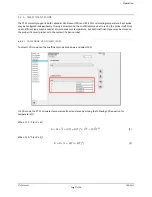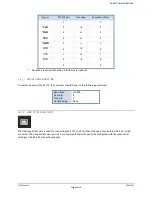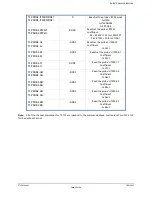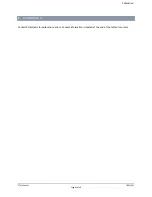
Operation
PT12
Manual
7/20/2021
Page
31
of
48
𝑊
𝑅
𝑅
[3]
ITS
‐
90
defines
two
reference
equations
for
an
ideal
probe.
One
equation
defines
resistance
ratio,
𝑊
,
as
a
function
of
temperature
in
a
range
below
the
triple
point
of
water,
the
other
equation
is
for
temperatures
above
the
triple
point.
Both
reference
equations
are
𝑖
th
order
polynomials
defined
as
𝑊
.
The
reference
equation
below
the
triple
point
of
water
(where
W
r
<1
and
T
<273.16K)
is:
ln
𝑊
𝐴
𝐴
ln
𝑇
273.16
𝐾
1.5
1.5
[4]
While
the
reference
equation
above
the
triple
point
of
water
(where
W
r
≥
1
and
T
≥
273.16K)
is:
𝑊
𝐶
𝐶
𝑇
754.15
481
[5]
Since
the
goal
is
to
calculate
temperature
from
resistance,
both
reference
equations
have
inverses.
The
inverse
temperature
reference
equation
below
the
triple
point
of
water
(where
W
r
≥
1
and
T
≥
273.16K)
is:
𝑇
273.16
∗ 𝐵
𝐵
𝑊
/
0.65
0.35
[6]
The
inverse
temperature
reference
equation
above
the
tripe
point
of
water
(where
W
r
≥
1
and
T
≥
273.16K)
is:
𝑇
𝐷
𝐷
𝑊
2.64
1.64
273.15
[7]
where
𝑇
is
the
temperature
in
Kelvin,
𝑊
is
the
reference
resistance
ratio,
and
𝐴
and
𝐶
are
constants
given
in
the
ITS
‐
90
standard.
See
the
ITS
‐
90
standard
for
a
more
complete
definition,
as
well
as
the
full
table
of
constants
for
𝐴
,
𝐵
,
𝐶
,
and
𝐷
.
No
probe
is
ideal
of
course.
Each
exhibit
small
deviations
that
make
their
temperature
vs.
resistance
characteristics
unique.
To
account
for
this,
ITS
‐
90
provides
“deviation
functions”
for
various
temperature
subranges,
each
with
their
own
equation
and
probe
specific
coefficients.
These
deviation
functions
provide
unique
probe
correction
to
the
reference
resistor
ratio
equation.
The
deviation
functions
utilized
by
the
PT12
are
listed
below.
ITS
‐
90
mode
below
triple
point
of
water
using
A4
,
B4
:
𝑊
𝑊
𝐴
4
𝑊
1
𝐵
4
𝑊
1
∗
ln
𝑊
[8]
ITS
‐
90
mode
above
triple
point
of
water
using
A,
B,
C
:
𝑊
𝑊
𝐴 𝑊
1
𝐵 𝑊
1
𝐶 𝑊
1
[9]
For
the
ITS
‐
90
mode
above
the
triple
point
of
water,
the
coefficients
for
A,
B,
and
C
are:
A7
‐
11,
B7
‐
11,
and
C7
‐
11.
Subrange
5
(SR5,
spans
triple
point
of
water)
using
A5,
B5
:
𝑊
𝑊
𝐴
5
𝑊
1
𝐵
5
𝑊
1
[10]
















































